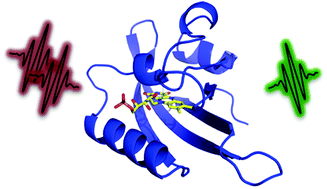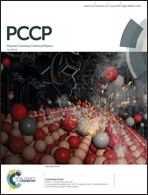Two photon spectroscopy and microscopy of the fluorescent flavoprotein, iLOV†
Abstract
LOV-domains are ubiquitous photosensory proteins that are commonly re-engineered to serve as powerful and versatile fluorescent proteins and optogenetic tools. The photoactive, flavin chromophore, however, is excited using short wavelengths of light in the blue and UV regions, which have limited penetration into biological samples and can cause photodamage. Here, we have used non-linear spectroscopy and microscopy of the fluorescent protein, iLOV, to reveal that functional variants of LOV can be activated to great effect by two non-resonant photons of lower energy, near infrared light, not only in solution but also in biological samples. The two photon cross section of iLOV has a significantly blue-shifted S0 → S1 transition compared with the one photon absorption spectrum, suggesting preferential population of excited vibronic states. It is highly likely, therefore, that the two photon absorption wavelength of engineered, LOV-based tools is tuneable. We also demonstrate for the first time two photon imaging using iLOV in human epithelial kidney cells. Consequently, two photon absorption by engineered, flavin-based bio-molecular tools can enable non-invasive activation with high depth resolution and the potential for not only improved image clarity but also enhanced spatiotemporal control for optogenetic applications.

- This article is part of the themed collection: 2018 PCCP HOT Articles


 Please wait while we load your content...
Please wait while we load your content...